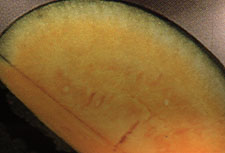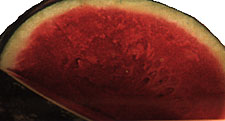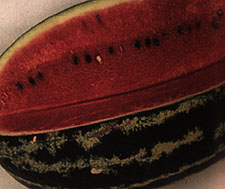

Calsweet

FoodFood InformationFruitMelons
Watermelons originated in Africa at least four thousand years ago. They
are edible gourds and are botanically in the same family as squash, cucumber,
and cantaloupe.
In the United States, Florida, Texas, and California are the top producing
areas, and most of the other southern states have substantial crops. They
are even grown as far north as Delaware. American grown watermelon are available
from April to November. When American watermelons are out of season, we
import them from Mexico and Central America.
There are many varieties of watermelon and they come in assorted sizes,
shapes, and skin colors. The flesh can either be red or yellow, but 99 percent
of the watermelon sold in the United States are of the red fleshed varieties.
They range in size from about as small as a honeydew (these are called Ice
Box watermelons) to exceeding fifty pounds. Some watermelons grown to compete
in contests reach weights of two hundred pounds. They are either oval or
round. In skin color, some are a solid dark green, some are a solid pale
green. Many varieties are variegated with alternating dark and pale green
stripes. The size, shape, and skin color have no bearing on the quality,
flavor, and ripeness of a watermelon.
The top-selling varieties include the pale green, oval Charleston Grays,
the dark green, round Black Diamonds and Peacocks; and the Sugar Sweets
and Klondikes, which are striped, oval melons. The Sugar Babies are small,
round, dark green Ice Box melons. Equally good flavor and texture can be
found in all varieties.
Seedless watermelons have been produced by experiments in the agricultural
schools, but attempts to grow them on a commercial scale have not yet been
fruitful. The seedless watermelons that I have sampled were not nearly as
sweet as watermelons with seeds. The few yellow fleshed watermelons I have
tried have also lacked flavor. There is a common but inaccurate belief that
the blacker the seeds, the more mature and flavorful the watermelon. However,
the color of the seed is determined by the variety, not the maturity, of
the melon. Some of our most flavorful varieties have light-colored seeds.
Prior to cutting open the watermelon, it is very difficult, if not impossible,
to judge its stage of maturity. Professional produce buyers will never buy
a load of watermelon without cutting several random samples. These melons
do ripen after being severed from the vine. The length of time that has
elapsed since harvesting can be determined by the condition of the pigtail
stem. When you purchase a watermelon, if the stem is fresh and green, the
melon is probably too immature to cut and needs a few more days of ripening.
After a few days the stem will shrink and discolor but will still be attached
to the watermelon. This is a sign that the watermelon has reached the desired
maturity. After another few days, the pigtail stem will part from the watermelon.
A tail less watermelon may be overripe.
Thumping a watermelon to check its ripeness is an exercise in futility.
The only foolproof way to judge the ripeness and the texture of a watermelon
is to cut it open. Retail markets sell cut watermelons by quarters and halves.
Purchasing a whole uncut watermelon is like buying a pig in a poke. Always
buy a quarter or a half and check it out for color. Even if a whole watermelon
is priced lower than two halves, it is wiser and safer to buy the cut melon.
The perfect watermelon will have a firm, dark red flesh. If the flesh is
pale and pink, it isn't quite ripe and will lack sweetness. If the flesh
is soft or shattered, the melon is overripe and will have a poor flavor
and texture. Even in a perfect watermelon, the blossom-end half is always
slightly riper and sweeter than the stem-end half.
Even though watermelons are now available year-round, they seem to taste
better when the mercury is in the eighties or nineties. Unlike other melons
and most fruits, which lose some flavor when served chilled, ice-cold watermelon
is at its flavor best.



WHEN TO BUY: At peak June through August
WHAT TO LOOK FOR: Never purchase a whole, uncut watermelon if it can be
avoided; flesh should be dark red and firm
HOW TO STORE: Refrigerate cut fruit immediately; store uncut fruit at room
temperature
Deamer 5/97